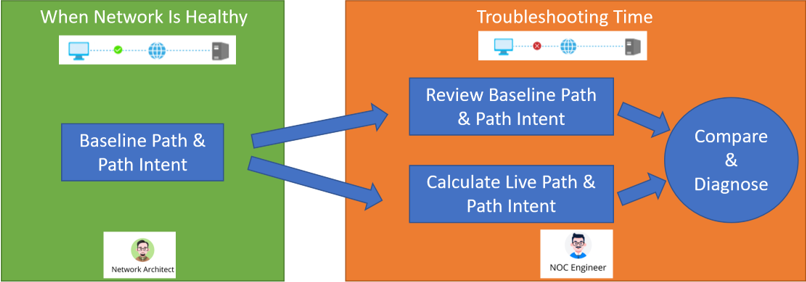NetBrain Path Calculator emulates the real packet forwarding process in your live network (including overlay and underlay networks) to map the forwarding path. It also enables you to baseline, document, and define the diagnosis logic for the application path efficiently when the network is healthy. Then this well-documented and executable knowledge can help you resolve application slowness issues more efficiently and do effective application impact analysis when a problem occurs on a network device or device interface.

![]()
Path-Based Troubleshooting Flow (PBTF) helps improve troubleshooting and impact analysis by using the following features:
-
Path Intent
-
Intent-based Trigger Automation Framework (TAF)
-
Path-related functions
PBTF enables users to:
-
Baseline, document, and define diagnosis logic for application paths while the network is healthy.
-
Create well-documented, executable knowledge for future use.
This structured approach allows network engineers to:
-
Troubleshoot application slowness issues more efficiently.
-
Perform effective application impact analysis when issues occur on a network device or interface.
Path-based Troubleshooting Flow
The PBTF is as follows:
Path-based Troubleshooting Flow
- Baseline Path and Path Intent (when the network is healthy)
When a network is healthy, the critical application flows can now be calculated via live network data with full documentation behind the path logic, and path-related baseline data and diagnosis logic can be programmatically defined inside path Intent. - Create ADT and replicate Path Intents to the ADT
Create ADT for the same path and add the member intents to the ADT via replication method. - Triggered Path-Based Diagnosis (during troubleshooting)
Configure ADT Intents for the Triggered Automation diagnosis. TAF receives the ticket sent by the third party and triggers the execution of ADT Intents according to the logic defined in TAF. TAF will execute the path ADT, which will run those member NIs specified for this application. The alert message for this path will be displayed in the Incident pane. - Review Baseline Path and Path Intent (during troubleshooting)
During troubleshooting time, the pre-documented application path can be intuitively accessed via the A|B path dialog by any network troubleshooter. The pre-documented path results, along with the pre-built diagnosis automation, will accelerate the slow application troubleshooting. - Calculate Live Path and Compare with Cached Path (during troubleshooting)
During troubleshooting, users can recalculate live paths and compare paths between live and cached data to reveal various issues behind a slow application. - Execute Path Intent and Diagnose Issues (during troubleshooting)
Users can rerun the associated path NI with the live network data and check the diagnosis results.
Main UI Components

The following topics are covered in this chapter (the superscript below refers to the corresponding number in the image above):